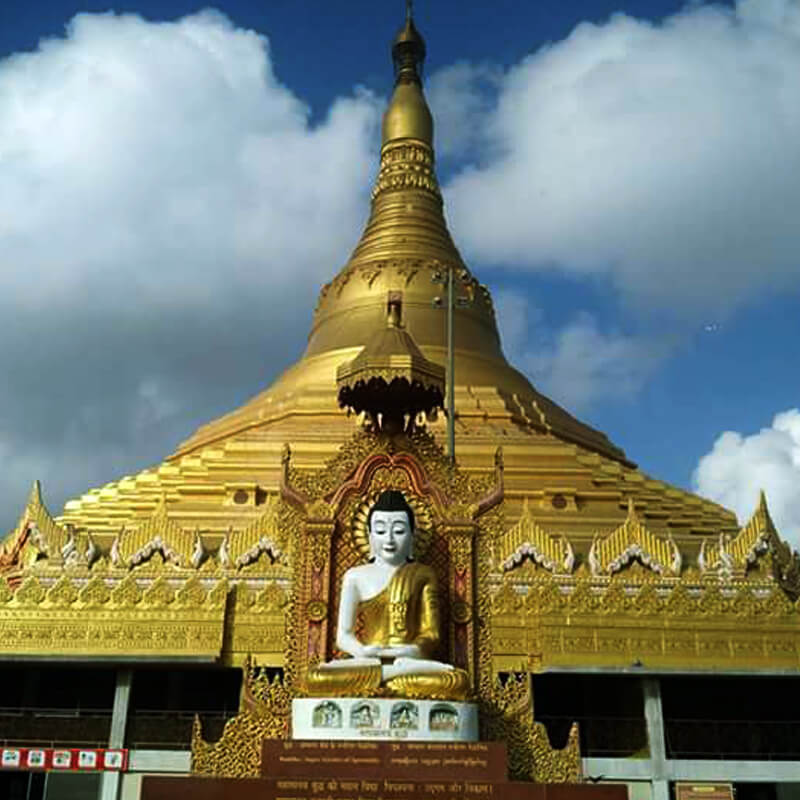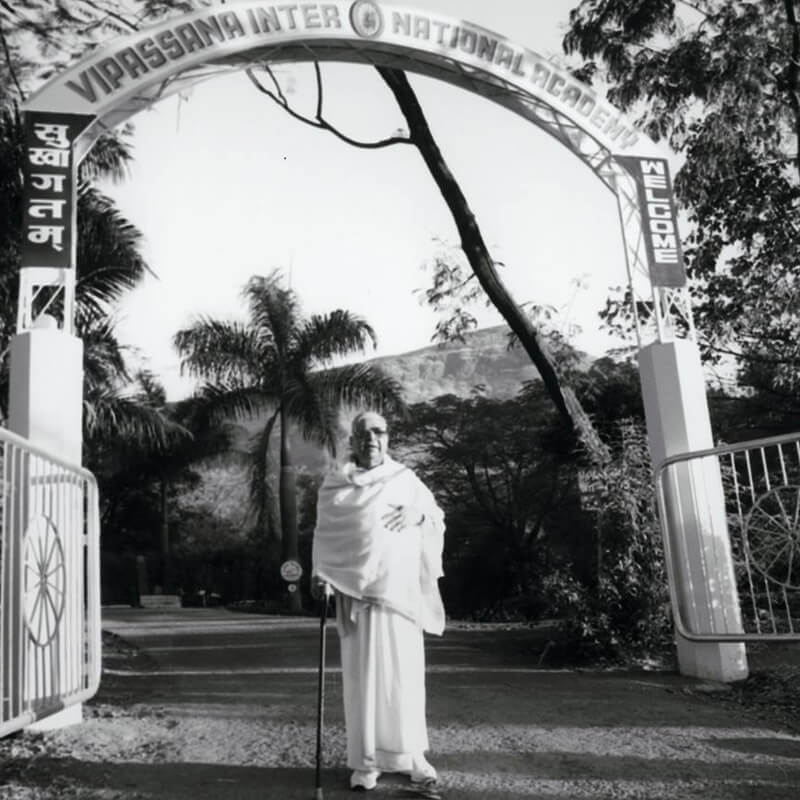- By Dr. R. Panth
The Vipassana Research Institute (VRI) was established in 1985 for the purpose of conducting research related to the technique of Vipassana meditation. This research has two main emphases: the publication and translation of literature in the Pali language, and research into the application of Vipassana in daily life.
Pali, the dialect in which the Buddha taught, was the lingua franca of northern India twenty-five centuries ago. The Pali literature includes the Tipitaka, the preserved words of the Buddha, commentarial works such as Atthakatha, Tika and Anutika, and other non-canonical literature. This Pali literature illumines and clarifies the Vipassana technique. From the time he became enlightened until his maha-parinibbana at the age of eighty, the Enlightened One wandered from place to place, teaching the Dhamma in villages and towns out of infinite love and compassion. Speaking to groups and individuals, renunciates and householders, he delivered tens of thousands of discourses. In all his addresses, the Buddha's theme was the same: sila (morality), samadhi (control of the mind), and panna (wisdom, insight, purification of the mind by wisdom). He taught a practical method to help mankind escape from the bonds of suffering: the Eightfold Noble Path, the quintessence of which is Vipassana.
Sources from the Pali literature offer a vivid account of the societal conditions during the Buddha's time. They describe how people from a wide spectrum of society were benefited by his ennobling doctrine: rich and poor, powerful and weak, learned and uneducated, privileged and downtrodden, without any distinction of caste or social position. The Enlightened One boldly declared all human beings equal, caste distinctions ignoble; debates and controversies on dogmas and philosophies, sterile; sectarian distinctions baneful. He declared: Dhamma is universal. Dhamma is the law of nature. He taught that every person must discover for himself what is conducive to his own good and welfare, and the good and welfare of others. He gave to humanity its first charter of freedom. To people steeped in ignorance, superstition, and blind beliefs; chained in rites and rituals; and fettered by the bonds of philosophical dogmas, he gave the possibility of a way out. This universal teaching brought profound relief to the suffering humanity. The door to freedom opened. A fresh wind blew which gradually swept the whole world. A new era in human history dawned; India was regarded as the World Teacher.
Today, in our own time, the Ganges of Truth is once again flowing out from India to a thirsty world. Between the centuries following the First Council and the present day, continuous and consistent efforts have been made to preserve the teaching. Periodic councils of learned monks have been convened to systematically review the Tipitaka.
The first three councils conducted oral reviews. The entire collection was committed to writing for the first time during the Fourth Council, held in Sri Lanka in 29 B.C. The most recent review, the Sixth Council, or Chattha Sangayana, was held in 1954 in Yangon, Myanmar (Burma). Twenty-five hundred learned bhikkhus and scholars from Myanmar, Sri Lanka, Thailand, Laos, Cambodia, India and other countries participated. By this time the Tipitaka and allied literature had been published in several scripts (including Burmese, Sinhalese, Thai, Cambodian, and Roman). The Pali Text Society of London, the Buddhist Publication Society of Sri Lanka and many scholars of high repute and dedication in the West and in the East had produced publications containing Buddha's teaching, making a profound contribution to the worldwide awakening to the existence of such a rich treasure.
The Chattha Sangayana made a thorough review of the Tipitaka, its Atthakathas, Tikas, Anutikas and other commentarial literature. A remarkable uniformity and consistency was found in all versions. The Council performed an impressive task, finishing its work on the full moon day of May 1956 (the 2,500th anniversary of the birth of Buddha) with the completion of an authentic version of the Master's teaching. From this brief historical outline, it is evident that a consistent effort, spanning more than twenty-five centuries, has been made to preserve the original words of the Buddha, a continuity of effort unparalleled in human history.
The world has a deep debt of gratitude to the country of Myanmar. This country maintained a tradition of preserving the words of the Buddha in their original form. And, equally importantly, the gem of the Enlightened One's teaching, the practice of Vipassana, was preserved there for over two millennia by a small number of devoted meditator bhikkhus and lay people. Unfortunately, the Pali texts and the practice of Vipassana were lost in India. Realizing the importance of the Pali canon as an invaluable part of the ancient heritage of India, the Government of India, after the Chattha Sangayana, took the decision to publish the entire Pali literature in Devanagari script. This task was entrusted to Nalanda Mahavihara, at the Nalanda Institute. The work of publishing the Tipitaka was undertaken in earnest, and the efforts of many eminent scholars culminated in the publication of the work in Devanagari. However, the work slowed down, and today the complete set of Tipitaka volumes is out of print. Even isolated volumes are not available. The sublime record of the Buddha's teaching in Devanagari is therefore now not readily available to those speaking the languages of the country in which it originated.
VRI has undertaken the monumental task of publishing the entire Pali Canon and allied commentarial literature. This work will supplement the efforts of Nalanda Mahavihara. VRI has taken the Chattha Sangayana version in Burmese script as the authentic, authoritative version. Pali scholars from India and other countries, including many learned bhikkhus and research scholars in Myanmar, are assisting in the work. The first phase is to provide an authentic version of the Tipitaka and allied literature in Devanagari script within three years. The work has already started. As a result Digha Nikaya in a set of eleven volumes is already printed. Majjhima Nikaya is under print. Most of the remaining texts have been typed into the computer.
Side by side, the publication work in Roman script has also started. Unlike the Devanagari publication project, the Institute will first publish those tikas which have not been published by the Pali Text Society, so that Western scholars and Vipassana students who are not conversant with the Devanagari script can also have access to such texts. In this way, the Roman publication project of VRI is only supplementary to the great work done by the P.T.S.
After the publication of the Pali literature, the translation work in Hindi language will be undertaken so as to help in the research work. This will be of great value to people in India interested in the original words of the Enlightened One. The Institute also plans to publish the texts in Bengali and other regional Indian scripts. The first phase of the Pali Publication Project has the following special features:
1. Simultaneous publication of Tipitaka and commentaries. VRI has made the decision to publish the Tipitaka and its commentarial literature simultaneously. (For example, the three volumes of Digha Nikaya, the first of the five sections of Sutta Pitaka, will be published along with its eight volumes of commentaries and subcommentaries.) The advantages of this feature, not hitherto accomplished in a Devanagari edition, can be readily appreciated. A deeper understanding of the teaching is possible when the Enlightened One's words and the learned commentaries can be studied together.
2. Indexing. With the aid of computers, a comprehensive index of relevant words and terms is being prepared for each book. In addition, an index of gathas will be made.
3. Cross-referencing. The entire document will be cross-referenced with the Roman edition of the Pali Text Society.
4. Highlighting references to Vipassana. References to Vipassana and related subjects in the entire Pali literature will be specifically highlighted, a very inspiring feature for students of the technique, as well as scholars.
5. Re-inclusion of formerly omitted passages. The Pali literature stems from an oral tradition where it was very common for the same phrases or passages to be repeated. Most previous printed versions have found it necessary to omit these repetitions (called "peyyala matter"). VRI has chosen to include repetitious passages whenever they are found to elucidate the understanding of Vipassana.
6. Summary of contents in Hindi. Every volume of the Tipitaka in Devanagari Pali will contain a brief summary in Hindi of the contents of that volume.
7. Separate publication of an Introduction. The Teacher, Shri S.N. Goenka, is preparing a comprehensive introduction to the Tipitaka in Hindi. Comprising several hundred pages and over 1,000 references from the Pali Canon, it will be published separately. This introductory overview of the entire Tipitaka by a highly respected Vipassana acharya is a unique contribution. It will illumine the essence of the Dhamma for the benefit of students of Vipassana, research scholars and all those interested in the Buddha's teaching.
8. Computer technology:
a. Conversion into other scripts. VRI has developed computer software capable of easily rendering the Devanagari script Pali texts into various other scripts, including Burmese, Sinhalese, Thai, Roman, etc.
b. Information storage. It is planned to store the Pali literature on CD-ROM (Compact Disk-Read Only Memory) storage medium, which will help to preserve this invaluable legacy indefinitely.
c. Tools for research. A computer program capable of locating any word or phrase in any part of the Tipitaka in a matter of seconds greatly enhances Pali research. With the inclusion of such software on CD-ROM, together with the entire Pali literature, VRI intends to share this technology with students and research scholars.
The Institute is conscious that the realization of its objectives calls for immense effort and dedication by students of Vipassana and interested scholars. The publication of the literature in the Pali literature in Devanagari script is just the beginning step in a great effort which, when fulfilled, will open up a vast panorama to India's rich cultural heritage. The Tipitaka, sometimes translated as "three treasuries," is indeed a repository of inestimable value. VRI is confident that its publication will assist in enabling scholars, scientists, and social reformers to undertake studies and research in various fields of human welfare in India and abroad. VRI will publish the Pali Tipitaka (the three baskets: Sutta Pitaka, Vinaya Pitaka and Abhidhamma Pitaka) and its commentarial literature in 133 volumes. A list of the main titles follows:
I. Sutta Pitaka a. Digha Nikaya set 1. Silakhandhavagga-pali 2. Mahavagga-pali 3. Pathikavagga-pali 4. Silakkhandavagga-atthakatha 5. Mahavagga-atthakatha 6. Pathikavagga-atthakatha 7. Silakkhandavagga-tika 8. Mahavagga-tika 9. Pathikavagga-tika 10. Silakkhandavagga-abhinavatika, Vol. I 11. Silakkhandavagga-abhinavatika, Vol. II b. Majjhima Nikaya set 1. Mulapanasa-pali 2. Majjhimapanasa-pali 3. Uparipanasa-pali 4. Mulapanasa-atthakatha, Vol. I 5. Mulapanasa-atthakatha, Vol. II 6. Majjhimapanasa-atthakatha 7. Uparipanasa-atthakatha 8. Mulapanasa-tika, Vol. I 9. Mulapanasa-tika, Vol. II 10. Majjhimapanasa-tika 11. Uparipanasa-tika c. Samyutta Nikaya set 1. Sagathavagga-samyutta-pali 2. Nidanavagga-samyutta-pali 3. Khandhavagga-samyutta-pali 4. Salayatanavagga-samyutta-pali 5. Mahavagga-samyutta-pali 6. Sagathavagga-samyutta-atthakatha 7. Nidanavagga- and Khandhavagga- samyutta-atthakatha 8. Salayatanavagga- and Mahavagga- samyutta-atthakatha 9. Sagathavagga-samyutta-tika 10. Nidanavagga- and Khandavagga- samyutta-tika 11. Salayatanavagga- and Mahavagga- samyutta-tika d. Anguttara Nikaya set 1. Eka-Duka-Tika-nipata-pali 2. Catukka-Pancaka-nipata-pali 3. Chakka-Sattaka-Atthaka-nipata- pali 4. Navaka-Dasaka-Ekadasaka-nipata- pali 5. Anguttara-atthakatha, Vol. I 6. Anguttara-atthakatha, Vol. II 7. Anguttara-atthakatha, Vol. III 8. Anguttara-tika, Vol. I 9. Anguttara-tika, Vol. II 10. Anguttara-tika, Vol. III e. Khuddaka Nikaya, Set 1 1. Khuddakapatha, Dhammapada, Udana, Itivuttaka and Suttanipata- pali 2. Khuddakapatha-atthakatha 3. Dhammapada-atthakatha, Vol. I 4. Dhammapada-atthakatha, Vol. II 5. Udana-atthakatha 6. Itivuttaka-atthakatha 7. Suttanipata-atthakatha, Vol. I 8. Suttanipata-atthakatha, Vol. II f. Khuddaka Nikaya, Set 2 1. Vimanavatthu, Petavatthu, Ther agatha and Therigatha-pali 2. Vimanavatthu-atthakatha 3. Petavatthu-atthakatha 4. Theragatha-atthakatha, Vol. I 5. Theragatha-atthakatha, Vol. II 6. Therigatha-atthakatha g. Khuddaka Nikaya, Set 3 1. Apadanapali, Vol. I 2. Apadanapali, Vol. II, Buddha vamsa and Cariyapitaka-pali 3. Apadana-atthakatha, Vol. I 4. Apadana-atthakatha, Vol. II 5. Buddhavamsa-atthakatha 6. Cariyapitaka-atthakatha h. Khuddaka Nikaya, Set 4 1. Jataka-pali, Vol. I 2. Jataka-pali, Vol. II 3. Jataka-atthakatha, Vol. I 4. Jataka-atthakatha, Vol. II 5. Jataka-atthakatha, Vol. III 6. Jataka-atthakatha, Vol. IV 7. Jataka-atthakatha, Vol. V 8. Jataka-atthakatha, Vol. VI 9. Jataka-atthakatha, Vol. VII 10 Ze me panasa i. Khuddaka Nikaya, Set 5 1. Mahaniddesa-pali 2. Culaniddesa-pali 3. Patisambhidamagga-pali 4. Netti and Petakopadesa-pali 5. Milindapanha-pali 6. Mahaniddesa-atthakatha 7. Culaniddesa-atthakatha and Netti- atthakatha 8. Patisambhidamagga-atthakatha, Vol. I 9. Patisambhidamagga-atthakatha, Vol. II 10. Petakopadesa-atthakatha 11. Milinda-atthakatha 12. Netti-tika and Nettivibhavini-tika 13. Milinda-tika II. Vinaya Pitaka a. Set 1 1. Parajika-pali 2. Pacittiya-pali 3. Parajikakan¹a-atthakatha, Vol. I 4. Parajikakan¹a-atthakatha, Vol. II 5. Pacittiya-atthakatha 6. Pacityadi-yojana-pali b. Set 2 1. Mahavagga-pali 2. Culavagga-pali 3. Parivara-pali 4. Mahavagga-atthakatha 5. Culavagga-atthakatha and Parivara-atthakatha c. Set 3 1. Kankhavitarani-atthakatha 2. Kankhavitarani-purana-tika and abhinava-tika 3. Kankhayojana-pali 4. Kankhayojana-mahatika-pali, Vol. I 5. Kankhayojana-mahatika-pali, Vol. II 6. Kankhayojana-mahatika-pali, Vol. III 7. Kankhayojana-mahatika-pali, Vol. IV d. Set 4 1. Vinayasangaha-atthakatha 2. Vajirabuddhi-tika 3. Saratthadipani-tika, Vol. I 4. Saratthadipani-tika, Vol. II 5. Saratthadipani-tika, Vol. III 6. Vimativinodani-tika, Vol. I 7. Vimativinodani-tika, Vol. II 8. Vinayalankara-tika, Vol. I 9. Vinayalankara-tika, Vol. II 10. Vinayavinicchaya-tika, Vol. I 11. Vinayavinicchaya-tika, Vol. II III. Abhidhamma Pitaka a. Set 1 1. Dhammasangani-pali 2. Vibhanga-pali 3. Dhatukatha and Puggalapannatti- pali 4. Dhammasangani-atthakatha 5. Vibhanga-atthakatha 6. Dhammasangani-mulatika and anutika b. Set 2 1. Kathavatthu-pali 2. Yamaka-pali, Vol. I 3. Yamaka-pali, Vol. II 4. Yamaka-pali, Vol. III 5. Patthana-pali, Vol. I 6. Patthana-pali, Vol. II 7. Patthana-pali, Vol. III 8. Patthana-pali, Vol. IV 9. Patthana-pali, Vol. V 10. Pancappakarana-atthakatha 11. Pancappakarana-mulatika and anutika Approximately 100 other volumes of miscellaneous nature including such works as Visuddhimagga, Abhidhammatthasangaha and its various tikas, Namarupapariccheda, Mahavamsa, Sasanavamsa, Gandhavamsa, Cula






